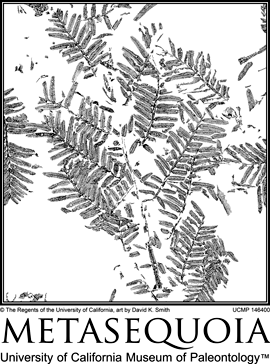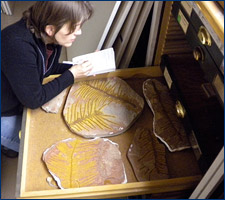About UCMP : News and events : UCMP newsletter
Tidbits
 |
|
On Sequoia and Metasequoia
by Diane Erwin
What do California and China have in common? Answer: redwoods. Although the modern Dawn Redwood, Metasequoia
glyptostroboides, is native to a remote region of central China, fossil species were growing in California 40 million years ago. California's State trees, the redwoods, Sequoia
sempervirens and Sequoiadendron giganteum, are the tallest and most massive conifers on Earth reaching heights of 85–115 m (279–380 ft.). The Dawn Redwood is relatively smaller in stature and deciduous. Extant redwoods are "relicts" of ancestral populations that grew throughout the Northern Hemisphere since the Cretaceous. As the Cenozoic climate became cooler and drier, redwood environments changed, causing them to die out. Coast redwoods survive in California thanks in part to coastal fog. A large part of Sequoia's water uptake comes from fog drip, leaving one to wonder about the future of these trees if summer fog continues to decrease. Giant Redwoods are restricted to small groves at mid-elevations in the Sierra Nevada and grow nowhere else in the world as native populations.


The design for the latest UCMP tee shirt featured Metasequoia. New tee shirts are introduced on Cal Day each year. |
|
Congratulations!
To Jean Alupay, Jessie Atterholt, Liz Ferrer, and Jenny Hofmeister who passed their oral exams!
To David Hurt, who has been awarded a National Science Foundation Graduate Research Fellowship to support his research on the potential effects of ocean acidification on the physiology and behavior of porcelain crabs during their development.
To Emily Lindsey who received the 2011 George D. Louderback award to support her research on the exchange of megafauna between North and South America.
To Rosemary Romero, who has been awarded the Office of the President's 2011–2012 Mentor Research Award.
To Allison Stegner who received an NSF Predoctoral Fellowship and also was accepted to attend the Paleobiology Database Quantitative Methods course in Australia. Allison is using the Quaternary paleontological record to understand how past and present-day communities are related.
Many thanks!
To Masahiko Nakayama for his very generous donation of his extraordinary shell collection! Due both to their rarity and beauty, many of the shells have already found their way into our teaching collections, and the remainder will be re-packaged into "kits" with suggested activities to motivate student learning and made available to local K-12 teachers. We are most appreciative!
And some sad news …
Harley Garbani, who worked with UCMP field parties in Montana since 1972, passed away April 20th. His many contributions to our collections include the hadrosaur skull exhibited in the atrium just outside the door to the museum and the skull of a very young Triceratops, a restoration of which is on display in the Biosciences library. Harley was a great friend of many generations of UCMP students and staff and he will be missed by all of us. We'll have more on Harley in the next issue of UCMP News.
Clues to the early evolution of plants
 |
 |

Cindy Looy takes notes on fossil conifers in the NMNH collections.
|
On a cold Berkeley morning late in March paleobotanist Cindy Looy and grad student Susan Tremblay hopped on a plane to Washington, DC. Their goal was not to enjoy the gorgeous spring weather and peaking cherry blossoms, but instead to search for clues to the early evolution of plants in the collections of the National Museum of Natural History (NMNH). Devonian liverworts and Permian conifers were on the menu ….
Intrigued? Then tune in to the UCMP blog where you can follow a series of articles on UCMP field work, work in the collections, featured fossils, UCMP events, and more!

